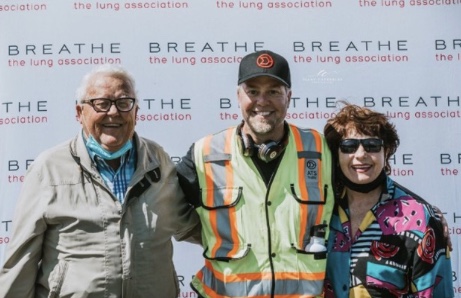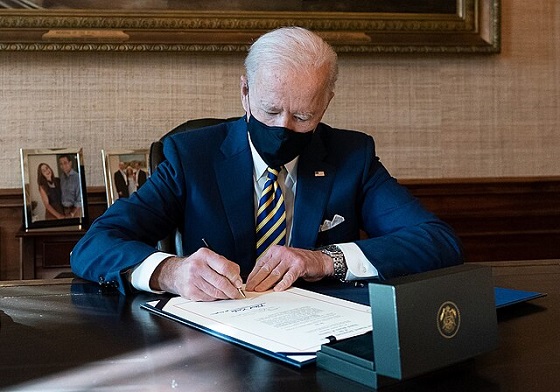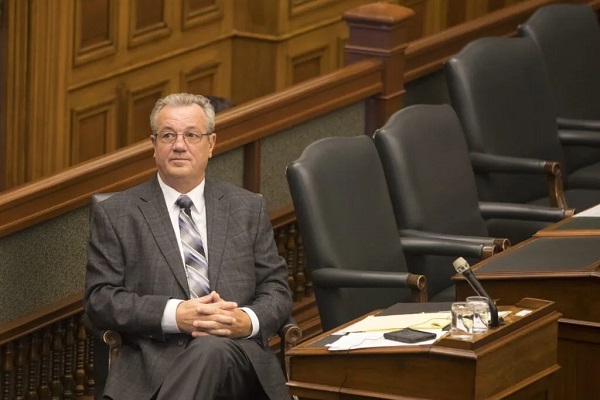Alberta
Walk To Breathe – Alberta man will walk from Lethbridge to Edmonton to raise $50,000.00

Article submitted by Chris Sadleir on behalf of The Lung Association, Alberta and NWT
July 7, Edmonton’s Chris Sadleir will take the first step in a 500-kilometre, 50-thousand dollar journey, a walk from Lethbridge to Edmonton in support of people living with lung disease in Alberta and the Northwest Territories. Last year, Sadleir’s inaugural walk took him from Calgary to Edmonton, and raised over 33-thousand dollars. At the time, it was meant to be a once-in-a-lifetime effort, one that turned out to raise even more awareness and engagement than Sadleir had dared to hope for, and ultimately, uniting Albertans from small towns, rural regions, and big cities in support of the cause.
Building on last year’s success, Sadleir will not just take on the challenge again, he is extending his route, his reach, and his goal for results.
The journey will commence in Lethbridge on July 7th and finish in Edmonton July 23rd – five years to the day that Sadleir’s father received his life-saving lung transplant. This year’s walk is in celebration of that milestone, and in commemoration of a dear family member who lost his life to respiratory complications earlier this year.
PLEASE UNDERSTAND: Lung Disease does NOT target smokers and the elderly – it affects EVERYONE – babies, young children, young adults and otherwise healthy people.
From Chis Sadleir:
I HUMBLY ask for your support in my WALK TO BREATHE, and the fight against lung disease. Your kindness and consideration is a BREATH OF FRESH AIR, as we work together to make a difference across Alberta and NWT.”
“In 2020, I walked from Calgary to Edmonton and raised over $33,000 to support lung disease patients and increase awareness about the far-reaching affects of lung disease.
This year, my Walk To Breathe will take me from Lethbridge to Edmonton – over 500 km, with a goal to raise $50,000 for the Lung Association of AB & NWT.
Having experienced the devastating affects of lung disease within my own family, I am passionate about supporting all those who struggle to breathe. My Father is a 5-year Double Lung Transplant survivor, and a very dear member of our family lost his life due to respiratory complications in early March – they are the inspiration behind my walk this year.
My Walk To Breathe 2021 will begin in Lethbridge on July 7th and finish in Edmonton on July 23rd – marking the 5-year anniversary of my father’s transplant.
I HUMBLY ask for your support in my WALK TO BREATHE, and the fight against lung disease.
“The inspiration comes from my Father – my determination is for ALL Albertans”
Your kindness and consideration is a BREATH OF FRESH AIR, as we work together to make a difference across Alberta and NWT.
Alberta
Alberta takes big step towards shorter wait times and higher quality health care

From the Fraser Institute
On Monday, the Smith government announced that beginning next year it will change the way it funds surgeries in Alberta. This is a big step towards unlocking the ability of Alberta’s health-care system to provide more, better and faster services for the same or possibly fewer dollars.
To understand the significance of this change, you must understand the consequences of the current (and outdated) approach.
Currently, the Alberta government pays a lump sum of money to hospitals each year. Consequently, hospitals perceive patients as a drain on their budgets. From the hospital’s perspective, there’s little financial incentive to serve more patients, operate more efficiently and provide superior quality services.
Consider what would happen if your local grocery store received a giant bag of money each year to feed people. The number of items would quickly decline to whatever was most convenient for the store to provide. (Have a favourite cereal? Too bad.) Store hours would become less convenient for customers, alongside a general decline in overall service. This type of grocery store, like an Alberta hospital, is actually financially better off (that is, it saves money) if you go elsewhere.
The Smith government plans to flip this entire system on its head, to the benefit of patients and taxpayers. Instead of handing out bags of money each year to providers, the new system—known as “activity-based funding”—will pay health-care providers for each patient they treat, based on the patient’s particular condition and important factors that may add complexity or cost to their care.
This turns patients from a drain on budgets into a source of additional revenue. The result, as has been demonstrated in other universal health-care systems worldwide, is more services delivered using existing health-care infrastructure, lower wait times, improved quality of care, improved access to medical technologies, and less waste.
In other words, Albertans will receive far better value from their health-care system, which is currently among the most expensive in the world. And relief can’t come soon enough—for example, last year in Alberta the median wait time for orthopedic surgeries including hip and knee replacements was 66.8 weeks.
The naysayers argue this approach will undermine the province’s universal system and hurt patients. But by allowing a spectrum of providers to compete for the delivery of quality care, Alberta will follow the lead of other more successful universal health-care systems in countries such as Australia, Germany, the Netherlands and Switzerland and create greater accountability for hospitals and other health-care providers. Taxpayers will get a much better picture of what they’re paying for and how much they pay.
Again, Alberta is not exploring an untested policy. Almost every other developed country with universal health care uses some form of “activity-based funding” for hospital and surgical care. And remember, we already spend more on health care than our counterparts in nearly all of these countries yet endure longer wait times and poorer access to services generally, in part because of how we pay for surgical care.
While the devil is always in the details, and while it’s still possible for the Alberta government to get this wrong, Monday’s announcement is a big step in the right direction. A funding model that puts patients first will get Albertans more of the high-quality health care they already pay for in a timelier fashion. And provide to other provinces an example of bold health-care reform.
Alberta
Alberta’s embrace of activity-based funding is great news for patients

 From the Montreal Economic Institute
From the Montreal Economic Institute
Alberta’s move to fund acute care services through activity-based funding follows best practices internationally, points out an MEI researcher following an announcement made by Premier Danielle Smith earlier today.
“For too long, the way hospitals were funded in Alberta incentivized treating fewer patients, contributing to our long wait times,” explains Krystle Wittevrongel, director of research at the MEI. “International experience has shown that, with the proper funding models in place, health systems become more efficient to the benefit of patients.”
Currently, Alberta’s hospitals are financed under a system called “global budgeting.” This involves allocating a pre-set amount of funding to pay for a specific number of services based on previous years’ budgets.
Under the government’s newly proposed funding system, hospitals receive a fixed payment for each treatment delivered.
An Economic Note published by the MEI last year showed that Quebec’s gradual adoption of activity-based funding led to higher productivity and lower costs in the province’s health system.
Notably, the province observed that the per-procedure cost of MRIs fell by four per cent as the number of procedures performed increased by 22 per cent.
In the radiology and oncology sector, it observed productivity increases of 26 per cent while procedure costs decreased by seven per cent.
“Being able to perform more surgeries, at lower costs, and within shorter timelines is exactly what Alberta’s patients need, and Premier Smith understands that,” continued Mrs. Wittevrongel. “Today’s announcement is a good first step, and we look forward to seeing a successful roll-out once appropriate funding levels per procedure are set.”
The governments expects to roll-out this new funding model for select procedures starting in 2026.
* * *
The MEI is an independent public policy think tank with offices in Montreal, Ottawa, and Calgary. Through its publications, media appearances, and advisory services to policymakers, the MEI stimulates public policy debate and reforms based on sound economics and entrepreneurship.
-

 Also Interesting2 days ago
Also Interesting2 days agoMortgage Mayhem: How Rising Interest Rates Are Squeezing Alberta Homeowners
-

 Justice2 days ago
Justice2 days agoCanadian government sued for forcing women to share spaces with ‘transgender’ male prisoners
-

 Alberta2 days ago
Alberta2 days agoAlberta takes big step towards shorter wait times and higher quality health care
-

 Business1 day ago
Business1 day agoStocks soar after Trump suspends tariffs
-

 COVID-191 day ago
COVID-191 day agoBiden Admin concealed report on earliest COVID cases from 2019
-

 MAiD2 days ago
MAiD2 days agoDisability rights panel calls out Canada, US states pushing euthanasia on sick patients
-

 COVID-192 days ago
COVID-192 days agoRandy Hillier wins appeal in Charter challenge to Covid lockdowns
-

 Business2 days ago
Business2 days agoTrump raises China tariffs to 125%, announces 90-day pause for countries who’ve reached out to negotiate





